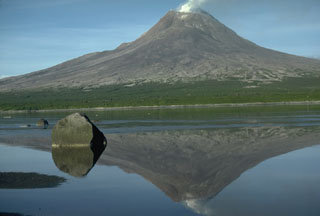Report on Augustine (United States) — May 1976
Natural Science Event Bulletin, vol. 1, no. 8 (May 1976)
Managing Editor: David Squires.
Augustine (United States) Nuées ardentes from frequent explosions in April; gas emission in May
Please cite this report as:
Global Volcanism Program, 1976. Report on Augustine (United States) (Squires, D., ed.). Natural Science Event Bulletin, 1:8. Smithsonian Institution. https://doi.org/10.5479/si.GVP.NSEB197605-313010
Augustine
United States
59.3626°N, 153.435°W; summit elev. 1218 m
All times are local (unless otherwise noted)
Augustine was very active for a considerable part of April. The eruptions produced mostly nuées ardentes, and during the peak of this period explosions were recorded on the University of Alaska's seismic system 10-15 minutes each hour, about 100 events per day. Deposits on the N and NE sides increased considerably, including those from numerous nuées ardentes. Since the activity was nuées ardentes, the troposphere was not affected.
The eruptions occurred as follows in April: 6th-9th, 6-12 per day; 10th-11th, about 1 every hour; 12th-14th, almost continuous; 15th-17th, very intense; 18th-22nd, 12 per day; 23rd, nuée ardente activity stopped.
Through the rest of April and all of May the volcano quieted, pouring out large quantities of gas and steam in a steady-state situation. Some of the plumes were reported to be rather spectacular.
Geological Summary. Augustine volcano, rising above Kamishak Bay in the southern Cook Inlet about 290 km SW of Anchorage, is the most active volcano of the eastern Aleutian arc. It consists of a complex of overlapping summit lava domes surrounded by an apron of volcaniclastic debris that descends to the sea on all sides. Few lava flows are exposed; the flanks consist mainly of debris-avalanche and pyroclastic-flow deposits formed by repeated collapse and regrowth of the summit. The latest episode of edifice collapse occurred during Augustine's large 1883 eruption; subsequent dome growth has restored the edifice to a height comparable to that prior to 1883. The oldest dated volcanic rocks on Augustine are more than 40,000 years old. At least 11 large debris avalanches have reached the sea during the past 1,800-2,000 years, and five major pumiceous tephras have been erupted during this interval. Recorded eruptions have typically consisted of explosive activity with emplacement of pumiceous pyroclastic-flow deposits followed by lava dome extrusion with associated block-and-ash flows.
Information Contacts: J. Kienle, Univ. of Alaska.

